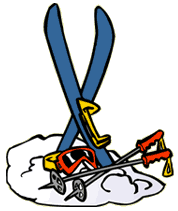SNOW SKIING ACTIVITY CARD
Parts of the Body Worked

Upper & Lower Legs

Heart & Lungs

Hips & Butt

Upper Body

Knees and Ankles

If you think you’re too young to learn how to ski, think again.
Gear Up
Skis. Are your skis the right size? If the tip of your upright ski reaches your face between your nose and chin, they are. If you’re a beginner, shorter skis will be easier to control. The bindings (the part that holds your boot to the ski) are the most important parts of the ski — to make sure they don’t break, get them tested regularly by a pro.
Make sure your boots fit and are comfortable. In general, ski boots are 1/2 size smaller than your normal shoe size.
Ski Helmets. Be a trendsetter by picking up the helmet habit. Choose an ASTM approved model that fits right, is ventilated, and doesn’t affect your hearing or field of vision.
Ski Poles are used to give you balance and help you get up if you fall, or need to side-step up a hill.
Goggles are important to protect your eyes from flying dirt or snow, as well as stopping the sun’s glare while whooshing down the slopes. Some goggles come with fun tinted lenses. If you don’t have goggles, you can use sunglasses instead.
If you are renting equipment, the staff at the ski shop can help you find all the right stuff.
Stay Warm on the Slopes
- Long underwear to keep you warm and absorb sweat.
- Insulated tops and pants such as sweaters and leggings — this layer should be warm, but not baggy.
- Ski pants and jackets to protect you from snow and wetness.
- A hat, because 60 percent of heat loss is through the head.
Play it Safe
If you can, sign up for lessons from a ski school, even if you’ve taken lessons before — your instructor can teach you all the right moves, for beginners as well as for more advanced students.
The key to skiing is control of your equipment and your speed. If you feel yourself start to lose control, fall onto your backside or your side and don’t attempt to get up until you stop sliding.
The easiest way to get hurt while skiing is to try a run or a move that is too hard. Always ski on trails that match your skill level and never attempt a jumping move, or other trick, unless taught by an instructor.
Did you know that it is just as important to drink water when you are active in the cold as in the heat? Why? Higher altitudes and colder air can cause your body to lose water. If you experience dizziness or have dry mouth, headache or muscle cramps, take a water break. A good rule would be to drink water or sports drinks before, during, and after your ski runs.
Always check the snow conditions of the slope before you go up — you’ll need to ski differently in icy conditions than you would if you were on wet snow or in deep powder.
Altitude can zap your energy. Don’t push it. Ski the easier runs later in the day when you are tired. Most importantly — know when to quit.
While on the slopes, set a meeting time and place to check in with your parents or friends. And always ski with a buddy. And wear plenty of sunblock, because those rays are strong on the mountain due to high altitude and reflection off the snow.
Be sure to keep the Responsibility Code for Skiers in mind:
Always stay in control and be able to stop or avoid other people or objects.
People ahead of you have the right of way. It is your responsibility to avoid them.
Do not stop where you obstruct a trail or are not visible from above.
Whenever starting downhill or merging into a trail, look uphill and yield to others.
Always use devices to help prevent runaway equipment.
Observe all posted signs and warnings. Keep off closed trails and out of closed areas.
Before using any lift, you must have the knowledge and ability to load, ride, and unload safely.
Finally, watch out for the sun! Wear a t-shirt and sunscreen to make sure you don’t get sunburned.
How to Play
Skiing can be done as a fun activity with your family or friends, and as your skills increase, you might even want to ski competitively There are several main skiing categories including alpine skiing, which is the fast-n-furious downhill skiing; freestyle skiing, in which skiers perform jumps and tricks over moguls (large bumps on the ski slope) while skiing downhill; and cross country skiing, where skiers race long distances over flatter land.
Here are some key tips to get you started:
To get on a lift, put both your poles in your inside hand. Turn to the outside and watch for the next chair. As it gets to you, grab the outside pole and sit normally on the chair. Keep your skis apart, with the tips up, as you’re lifted off the ground.
To get off the lift, grab a pole in each hand, but don’t put on your wrist straps. Point the pole tips toward the outside of the chair, and hold them up so they don’t catch on the snow. Hold the bar on the outside of the chair for balance, relax your legs, and ease yourself forward, pushing off once your skis touch the snow. Don’t stand up until the chair has passed over the top of the mound, and move away from the chairlift before you prepare to ski so that others can get off behind you.
Getting up after a fall. Make sure your skis are below you on the hill. Grab the top of both poles in one hand, grab the bottom of both with the other, and plant your poles in the snow just above your hip. Push up with both arms to shift yourself forward and over your skis. Make sure your weight is forward and over your skis before you stand up.
Fun Facts
Competitive freestyle skiers can jump as high as a 3 or 4 story building, when performing tricks in the air.
Before it was a sport, skiing was used as a form of transportation in the mountains of Europe.
Men are allowed to compete in the Olympic ski jumping event, but women are not.
Related Links
- Page last reviewed: May 9, 2015
- Page last updated: May 9, 2015
- Content source:



 ShareCompartir
ShareCompartir